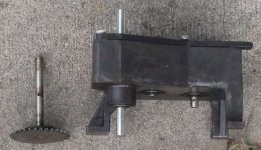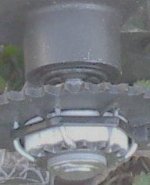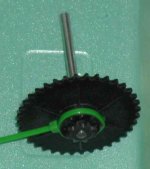Solcar
10 kW
I have done some evaluation on the service capability of the gearbox (http://www.herbach.com/Merchant2/merchant.mv?Screen=PROD&Store_Code=HAR&Product_Code=TM92MEC1999)
I have been using on my ebike. I've put about 5000 miles on it over about 14 years. I have never put more than about 300 watts through it. When I took it open lately to work on replacing the output shaft with a new, longer one machined to accept one of those common 15 tooth freewheeling sprockets
(http://www.electricscooterparts.com/SPR-2515F.htm)
for #25 chain, I noticed that the gears have worn to the point where breakage appears to be likely before long. The teeth are probably worn by 50%.
That leads into my wondering about the idea of a hydraulic transmission to transfer power from the motor to the wheel. I can surmise that efficiency would be lower. Who else has wondered some about the feasibility of using a hydraulic tranny? It ought to be able to give a lot of load matching (in a gear reduction sense) if nothing else.
http://en.wikipedia.org/wiki/Hydraulic_bicycle

I have been using on my ebike. I've put about 5000 miles on it over about 14 years. I have never put more than about 300 watts through it. When I took it open lately to work on replacing the output shaft with a new, longer one machined to accept one of those common 15 tooth freewheeling sprockets
(http://www.electricscooterparts.com/SPR-2515F.htm)
for #25 chain, I noticed that the gears have worn to the point where breakage appears to be likely before long. The teeth are probably worn by 50%.
That leads into my wondering about the idea of a hydraulic transmission to transfer power from the motor to the wheel. I can surmise that efficiency would be lower. Who else has wondered some about the feasibility of using a hydraulic tranny? It ought to be able to give a lot of load matching (in a gear reduction sense) if nothing else.
http://en.wikipedia.org/wiki/Hydraulic_bicycle





